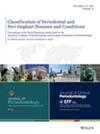From primary to secondary care level: Assessing patient retention of periodontal staging and grading information.
IF 3.8
2区 医学
Q1 DENTISTRY, ORAL SURGERY & MEDICINE
引用次数: 0
Abstract
BACKGROUND Accurate communication of periodontal stage and grade by general dentists in primary care is critical for patient understanding and engagement, yet patient retention and self-reporting of this information upon referral to secondary care remains unclear. METHODS A total of 372 periodontal patients referred were informed about their diagnosis by their general dentists and then referred to secondary care level. Data were collected through an eight-item periodontal staging and grading (PSG) questionnaire, along with demographic, medical, and dental records. Periodontal diagnoses were classified by a specialist using the 2018 classification system. Associations between clinical diagnosis and patient perception were analyzed using Chi-square tests and Spearman's rank correlation. RESULTS While 46.9% of patients diagnosed with periodontitis reported to be informed of their condition, only 19.3% reported knowing their specific stage and grade. Among patients with advanced periodontitis (stage III/IV), self-reported severity often aligned with clinical staging. However, for early-stage disease (stage I/II), perceptions were less accurate, and only 30.2% of grade C patients recognized rapid progression. Significant correlations were found between patient-reported symptoms and clinician-assigned staging: tooth loss (ρ = 0.69, p < 0.0001), root exposure (ρ = 0.638, p < 0.0001), and tooth mobility (ρ = 0.55, p < 0.0001). CONCLUSION Most patients referred to secondary care lacked information on their disease stage and grade. Severe stages and grades were better perceived by patients compared with mild forms of periodontitis. The PSG questionnaire offers a valuable tool for identifying knowledge gaps and guiding tailored discussions in clinical practice. PLAIN LANGUAGE SUMMARY Our study asked 372 people referred for gum disease to fill out a simple eight-question survey about how they see their own gum health and compared their answers to the detailed diagnosis made by periodontists. We found that fewer than one in five patients knew exactly how severe their disease was or how fast it was progressing. People with more advanced gum damage generally understood their condition, but those with mild disease often thought they were healthier than they really were. When patients reported losing teeth, seeing root surfaces, or noticing loose teeth, these experiences matched closely with the clinical measures of disease severity. These results show that many patients lack clear information about their gum health and that a brief questionnaire can help dentists pinpoint misunderstandings, improve patient education, and support better treatment decisions.从初级到二级护理水平:评估患者对牙周分期和分级信息的保留。
背景:在初级保健中,普通牙医对牙周分期和等级的准确沟通对患者的理解和参与至关重要,但患者在转诊到二级保健时对这些信息的保留和自我报告尚不清楚。方法372例牙周病患者由其普通牙医告知其诊断,然后转介至二级保健级别。数据通过一份包含8个项目的牙周分期和分级(PSG)问卷以及人口统计、医疗和牙科记录收集。牙周诊断由专家使用2018年分类系统进行分类。采用卡方检验和Spearman秩相关分析临床诊断与患者感知之间的关系。结果46.9%的牙周炎患者被告知自己的病情,只有19.3%的患者知道自己的具体分期和分级。在晚期牙周炎(III/IV期)患者中,自我报告的严重程度通常与临床分期一致。然而,对于早期疾病(I/II期),感知不太准确,只有30.2%的C级患者认识到快速进展。患者报告的症状与临床医生指定的分期之间存在显著相关性:牙齿脱落(ρ = 0.69, p < 0.0001)、牙根暴露(ρ = 0.638, p < 0.0001)和牙齿活动性(ρ = 0.55, p < 0.0001)。结论大多数到二级医疗机构就诊的患者缺乏疾病分期和分级信息。与轻度牙周炎相比,患者对严重牙周炎的分期和分级有更好的认识。PSG问卷为识别知识差距和指导临床实践中量身定制的讨论提供了有价值的工具。你的研究要求372名牙周病患者填写一份简单的8个问题的调查问卷,了解他们如何看待自己的牙龈健康,并将他们的回答与牙周病医生的详细诊断进行比较。我们发现,不到五分之一的患者确切知道他们的疾病有多严重或进展有多快。患有严重牙龈损伤的人通常了解自己的状况,但那些患有轻微疾病的人往往认为自己比实际情况更健康。当患者报告牙齿脱落、看到牙根表面或注意到牙齿松动时,这些经历与疾病严重程度的临床指标密切相关。这些结果表明,许多患者对自己的牙龈健康缺乏明确的信息,一份简短的调查问卷可以帮助牙医找出误解,改善患者教育,并支持更好的治疗决策。
本文章由计算机程序翻译,如有差异,请以英文原文为准。
求助全文
约1分钟内获得全文
求助全文
来源期刊

Journal of periodontology
医学-牙科与口腔外科
CiteScore
9.10
自引率
7.00%
发文量
290
审稿时长
3-8 weeks
期刊介绍:
The Journal of Periodontology publishes articles relevant to the science and practice of periodontics and related areas.
 求助内容:
求助内容: 应助结果提醒方式:
应助结果提醒方式:


